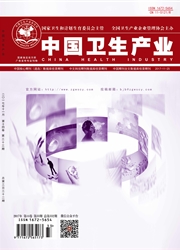

 中文摘要:
中文摘要:
亚健康儿指的是一种临界状态,处于亚健康状态的人,虽然没有明确的疾病,但却出现精神活力和适应能力的下降,如果这种状态不能得到及时的纠正,非常容易引起心身疾病。亚健康即指非病非健康状态,这是一类次等健康状态,是界乎健康与疾病之间的状态,故又有"次健康"、"第三状态"、"中间状态"、"游移状态"、"灰色状态"等的称谓。世界卫生组织将机体无器质性病变,但是有一些功能改变的状态称为"第三状态",我国称为"亚健康状态"。目的探讨在城镇社区儿童中施行中医保健干预管理模式的方法及效果。方法选取2013年1月—2015年1月间于"区妇幼保健院+社区卫生服务中心"联动中医保健干预管理模式中转诊我院的1228例0-3岁亚健康儿作为临床研究对象,使用随机数字列表将所有亚健康儿随机分为研究组和对照组,每组各614例。对照组儿童采用常规健康体检,研究组儿童在对照组的基础上加用中医保健干预管理模式进行干预。观察和比较两组儿童的干预效果。结果经干预后,本次研究中研究组614例亚健康儿中共有551例转为正常,转归率为(89.74%),对照组614例亚健康儿中共有356例转为正常,转归率为(57.98%)。研究组亚健康儿的转归率明显高于对照组,(P〈0.05)差异均有统计学意义。结论中医保健干预管理模式在城镇社区亚健康儿的干预防治方面具有良好的效果,值得在城镇社区儿童保健管理工作中进一步推广。
 英文摘要:
英文摘要:
The sub healthy children refers to a critical state, the people in sub-health state, although no specific disease, but mental activity and decreased ability to adapt, if it cannot be corrected in a timely manner, very easily lead to psychosomatic dis-ease. Sub health refers to the non disease health status, it is a kind of inferior health, is between health and disease state, and therefore "health", "third state", "intermediate state", "unstable", "gray state" and other titles. WHO body no organic disease, but there are some functional changes of the state is referred to as the "third state", China called the "sub healthy state". Objective To investigate the effect of management mode of traditional Chinese medicine health care intervention in children and the effect of ur-ban community. Methods From 2013 January-2015 year in January in the "District Maternal and child health care and community health service center" of traditional Chinese medicine health management mode of linkage intervention referral in our hospital1228 cases of 0-3 years old healthy children as the study object, using a random number list will all sub healthy infants were ran-domly divided into study group and control group, each group in 614 cases. Children in the control group with routine health examination, the children of group intervention combined with traditional Chinese medicine health management model on the basis of the control group. Intervention effects were observed and compared between the two groups of children. Results After the intervention, the study group and 614 cases of healthy children in a total of 551 cases returned to normal, turnover rate was(89.74%), 614 cases in the control group of healthy children in a total of 356 patients returned to normal, turnover rate was(57.98%). The outcome of sub healthy infants visible group was significantly higher than that of control group(P〈0.05), the differences were statistically significant. At the same time, the survey found that the
 同期刊论文项目
同期刊论文项目
 同项目期刊论文
同项目期刊论文
 期刊信息
期刊信息
